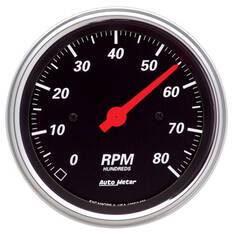Boost Your Driving Experience with a Trusted Tachometer
The Importance of a Tachometer in Monitoring Engine Speed and Performance in Automotive Applications
In the realm of automotive design, the tachometer stands as a crucial instrument in the vehicle driver's collection, giving a straight window right into the internal operations of a car's engine. Past its feature as a plain scale of revolutions per minute (RPM), the tachometer serves as a vital tool for lovers and specialists alike, offering real-time understandings right into engine efficiency and health.
Relevance of Keeping Track Of Engine RPM
Keeping an eye on engine RPM, or changes per min, is a vital element of automobile maintenance and efficiency examination. Engine RPM straight correlates with the speed at which the engine's crankshaft turns, indicating exactly how promptly the engine is running.
In addition, checking engine RPM is important for efficiency evaluation in racing and high-performance automobiles. In summary, keeping an eye on engine RPM is not only crucial for spotting concerns however likewise for enhancing engine performance in numerous vehicle applications.

Benefits of Real-Time Information
In vehicle applications, real-time information plays an essential role in giving immediate insights into the performance and condition of the car. By constantly keeping track of different criteria such as engine speed, temperature, gas usage, and extra, real-time data uses numerous benefits that add to boosted performance and safety and security on the roadway.
One significant advantage of real-time data is its ability to alert drivers and technicians to any anomalies or concerns promptly. This positive approach makes it possible for quick identification of prospective issues, enabling timely interventions to stop more damages or breakdowns. Additionally, real-time data assists in performance optimization by offering immediate feedback on driving practices and engine effectiveness. Chauffeurs can change their habits in real-time based upon this info to attain much better gas economy and lengthen the lifespan of their vehicle.

Furthermore, real-time data plays a crucial duty in contemporary automobile diagnostics, allowing service technicians to quickly diagnose and address malfunctions. This brings about minimized downtime, reduced upkeep expenses, and eventually, enhanced general automobile integrity and long life (tachometer). By using the power of real-time data, vehicle see here stakeholders can make informed choices that positively affect both the efficiency and longevity of the vehicle
Effect On Gear Shifts
The tachometer plays a critical role in maximizing equipment changes by offering real-time engine rate information to the motorist. When approaching the redline on the tachometer, it indicates the driver to upshift to stop over-revving the engine and triggering potential damages.
Moreover, the tachometer aids in accomplishing smoother gear changes, specifically in hand-operated transmissions. By monitoring engine speed, chauffeurs can carry out equipment changes at the optimal RPM array, reducing snagging motions and reducing wear on the transmission parts. This precision in equipment adjustments not only boosts driving comfort yet likewise contributes to fuel efficiency.
Enhancing Fuel Effectiveness
Given the important duty the tachometer plays in maximizing equipment changes for performance and engine health and wellness, it directly adds to making best use of gas effectiveness in auto applications. By offering real-time comments on engine speed, the tachometer assists vehicle drivers in preserving one of the most effective RPM range for fuel economy. When drivers continually keep an eye on the tachometer and readjust their driving practices as necessary, they can prevent unnecessary fuel intake brought on by over-revving or carrying the engine.
Furthermore, the tachometer aids motorists recognize the most fuel-efficient equipment to be in at any type of given minute, preventing the engine from working harder than essential. In conclusion, the tachometer offers as a valuable device in improving fuel performance by promoting optimal driving behaviors and determining areas for renovation in the lorry's efficiency.

Optimizing Engine Longevity
The tachometer's role in checking engine rate and performance is instrumental in making sure the longevity of auto engines. Keeping track linked here of the tachometer permits chauffeurs to remain within the suggested RPM array for their automobile, preventing Recommended Reading unneeded pressure on the engine and extending its life-span.

Final Thought
Finally, the tachometer plays a vital function in keeping an eye on engine rate and performance in auto applications. By supplying real-time data on RPM, it enables efficient equipment changes, improved gas efficiency, and taken full advantage of engine longevity. This device is essential for keeping optimal engine performance and making certain the general capability of an automobile.